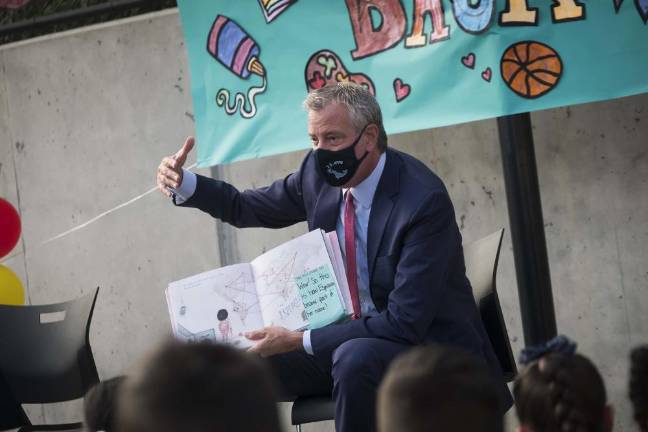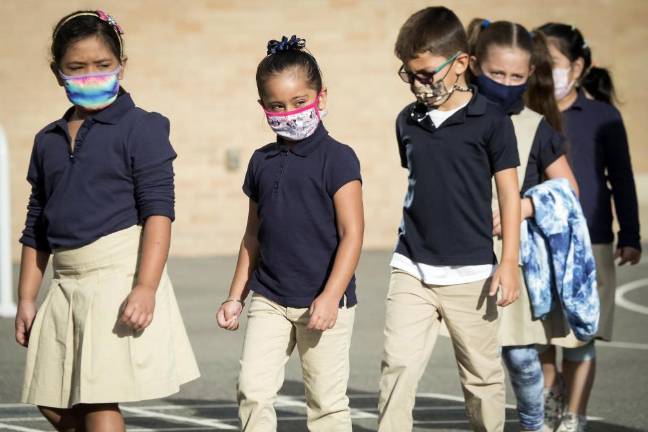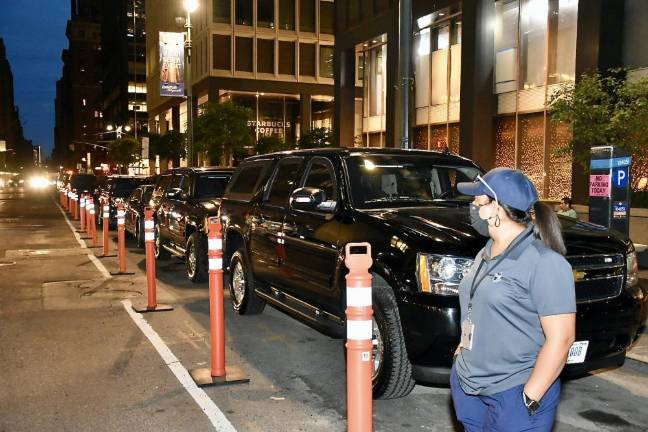COVID September
City rituals with a pandemic difference: back to school, UN General Assembly, riders on mass transit



Kids went back to school, but could they stay there?
Delegates returned to the United Nations, some of them, anyway.
Riders boarded subways and commuter trains in greater numbers than at anytime since the start of last year, but were growing lax about wearing their masks.
And international travelers were told they could soon work or vacation in New York again, if they are vaccinated.
This was the second half of September in New York, in year two of the global pandemic that has now taken more American lives than the Spanish flu a hundred years before.
Hints of revival could be found everywhere, in a New York style.
Vaccine mandates were increasing vaccination rates and with them, the hope that something like normal could resume.
But enforcement created conflicts, from a shoving match outside Carmine’s Restaurant on Broadway to warnings that there will not be enough vaccinated teachers and staff to keep the schools open.
BACK TO SCHOOL
Nothing was as dramatic, or as important to the city’s reopening, as the return to in person schooling. Online learning was, well, a mixed success. There are deep concerns about a lost year of lessons, particularly for children from less advantaged communities.
“We have the twin goal, first keeping kids safe,” said the Health Commissioner, Dave Chokshi, who has taken to calling himself the city’s doctor. “Second, keeping kids in school, learning in-person as much as possible.”
As he described the search for that balance, which sometimes came across as ever-changing rules, the good doctor couldn’t resist a medical image, saying the city was applying “a scalpel to our quarantine policy.”
Specifically, the city had decided to expand to every week the testing of students and staff across the city’s sprawling system and thus be more selective in who would need to be quarantined for exposure to someone who tested positive.
“Making sure,” Chokshi explained, “that it is truly only those children who are at highest risk of exposure to someone who is identified as a confirmed case in the classroom. And those are kids who are either within three feet or unmasked. And that has to happen for a sufficient duration of time for that to be considered a close contact and for that child to quarantine. So, taken together, this allows us to strike the balance of both keeping kids safe while ensuring that kids remain in school when it is safe for them to do so.”
If that sounded complicated, parents could be reassured that this intensified testing is what Chokshi described as just the first of the two key elements of the city’s plan to keep kids safe and in school. The other was the mandate, originally set to take effect at the end of the day Monday, September 27, that all teachers and staff be vaccinated.
However, what became clear is that the goal of universal vaccination among school employees would not be met by the deadline. What was less clear is what will then happen. With better than one staffer in ten still unvaccinated, unions warned that debilitating shortages will disrupt both instruction and non academic activities, like lunch.
But the city insisted it had plenty of fill-in teachers and other staff to pick up the slack.
The moment of truth was briefly delayed as a federal court reviewed objections to the mandate. But Monday evening the court said the city could proceed. The city said the mandate would now take effect as of the end of the day Friday, October 1.
GENERAL ASSEMBLY RETURNS, SORT OF
Nothing says September in New York quite like the week of events and gridlock related to the annual meeting of the General Assembly of the United Nations.
“It’s one of the things that makes New York City stand out in the entire world, the United Nations,” Mayor De Blasio said as he welcomed the resumption of the global gathering in person.
“We all don’t love the traffic, for sure, but what we do love is the fact that people can get back together in-person. It’s a very hopeful sign. It’s a great moment for New York City.”
The city was so eager to encourage this resumption that to help delegates gather safely it even parked a vaccination van outside United Nations headquarters, although the mayor, a vigorous progressive, also told the president of Brazil, Jair Bolsonaro, a fierce populist, that he should not come if he wasn’t vaccinated.
He came anyway, ate pizza on the street because he couldn’t meet New York’s vaccination requirement for indoor dining, and then for good measure quarantined when he returned to Brazil.
In the end, the gathering had a strange feeling of incompleteness. Attendees had trouble figuring out when events were in person or virtual. Traffic was up, but nothing like a General Assembly on the East Side before the pandemic.
MASS TRANSIT
Subway ridership is perhaps the quintessential measure of the city’s economic health. How is the patient faring? Clear signs of recovery might be the best description, although still a way to go.
Daily subway ridership surpassed 3 million on September 14, a Tuesday, for the first time since the pandemic. The strengthening continued this past week, with more than three million riders on several days. However, this was still only about half of daily ridership before the pandemic.
Perhaps most intriguing, ridership rose to the highest levels since the pandemic on commuter lines into the city from Long Island, Westchester and Connecticut, a sign that the return to office work is, if not swift, steady.
One concern is that as mass transit ridership increases, adherence to COVID safety rules is falling. The Transit Authority said compliance with the requirement to wear a mask on the subways had fallen from 90 percent to 70 percent. The authority said it would crack down with enforcement and fines.
INTERNATIONAL VISITORS
The collapse of travel during the pandemic dealt an especially heavy blow to New York’s entertainment and tourism businesses. No one is missed more than the international travelers who spent more and stayed longer than any other travelers.
So perhaps the very best piece of news for New York came from Washington, where the Biden administration said that it was lifting most of the bans on travelers coming to the United States, as long as they were vaccinated and get tested, too.
The new rules will take effect in November, perhaps in time to make a material difference for the December holiday season.
“We have the twin goal, first keeping kids safe. Second, keeping kids in school, learning in-person as much as possible.” Health Commissioner Dave Choksi